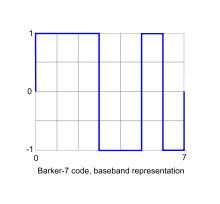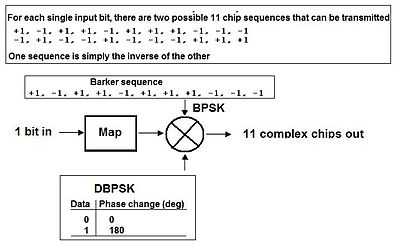Barker code


A Barker code or Barker sequence is a finite sequence of N values of +1 and −1,
 for
for 
such that the off-peak autocorrelation coefficients
are as small as possible:
for all  .[1] Only eight Barker sequences are known, all of length N at most 13.[2] Barker's 1953 paper asked for sequences with the stronger condition
.[1] Only eight Barker sequences are known, all of length N at most 13.[2] Barker's 1953 paper asked for sequences with the stronger condition
only three such sequences are known.[2]
Known Barker codes
Here is a table of all known Barker codes, where negations and reversals of the codes have been omitted. A Barker code has a maximum autocorrelation sequence which has sidelobes no larger than 2, and which thus has better RMS performance than the codes below. The table below shows all known Barker codes; it is conjectured that no other perfect binary phase codes exist.[3]
| Length | Codes | |
|---|---|---|
| 2 | +1 −1 | +1 +1 |
| 3 | +1 +1 −1 | |
| 4 | +1 +1 −1 +1 | +1 +1 +1 −1 |
| 5 | +1 +1 +1 −1 +1 | |
| 7 | +1 +1 +1 −1 −1 +1 −1 | |
| 11 | +1 +1 +1 −1 −1 −1 +1 −1 −1 +1 −1 | |
| 13 | +1 +1 +1 +1 +1 −1 −1 +1 +1 −1 +1 −1 +1 | |
Barker codes of length N equal to 11 and 13 are used in direct-sequence spread spectrum and pulse compression radar systems because of their low autocorrelation properties (The sidelobe level of the Barker codes is 1/N2 that of the peak signal).[4] A Barker code resembles a discrete version of a continuous chirp, another low-autocorrelation signal used in other pulse compression radars.
The positive and negative amplitudes of the pulses forming the Barker codes imply the use of biphase modulation; that is, the change of phase in the carrier wave is 180 degrees.
Pseudorandom number sequences can be thought of as cyclic Barker Codes, having perfect (and uniform) cyclic autocorrelation sidelobes. Very long pseudorandom number sequences can be constructed.
Similar to the Barker Codes are the complementary sequences, which cancel sidelobes exactly; the pair of 4 baud Barker Codes in the table form a complementary pair. There is a simple constructive method to create arbitrarily long complementary sequences.
Barker modulation

In wireless communications, sequences are usually chosen for their spectral properties and for low cross correlation with other sequences likely to interfere. In the 802.11b standard, an 11-chip Barker sequence is used for the 1 and 2 Mbit/sec rates. The value of the autocorrelation function for the Barker sequence is 0 or ±1 at all offsets except zero, where it is +11. This makes for a more uniform spectrum, and better performance in the receivers.[5]
References
- ↑ Barker, R. H. (1953). "Group Synchronizing of Binary Digital Sequences". Communication Theory. London: Butterworth. pp. 273–287.
- ↑ 2.0 2.1 Borwein, Peter; Mossinghoff, Michael J. (2008). "Barker sequences and flat polynomials". In James McKee; Chris Smyth. Number Theory and Polynomials. LMS Lecture Notes 352. Cambridge University Press. pp. 71–88. ISBN 978-0-521-71467-9.
- ↑ Weisstein, Eric W., "Barker Code", MathWorld.
- ↑ Introduction to Radar Systems, 3rd Edition, Merrill I. Skolnik, McGraw-Hill, 2001
- ↑ "802.11 & 802.11b" cp.literature.agilent.com


